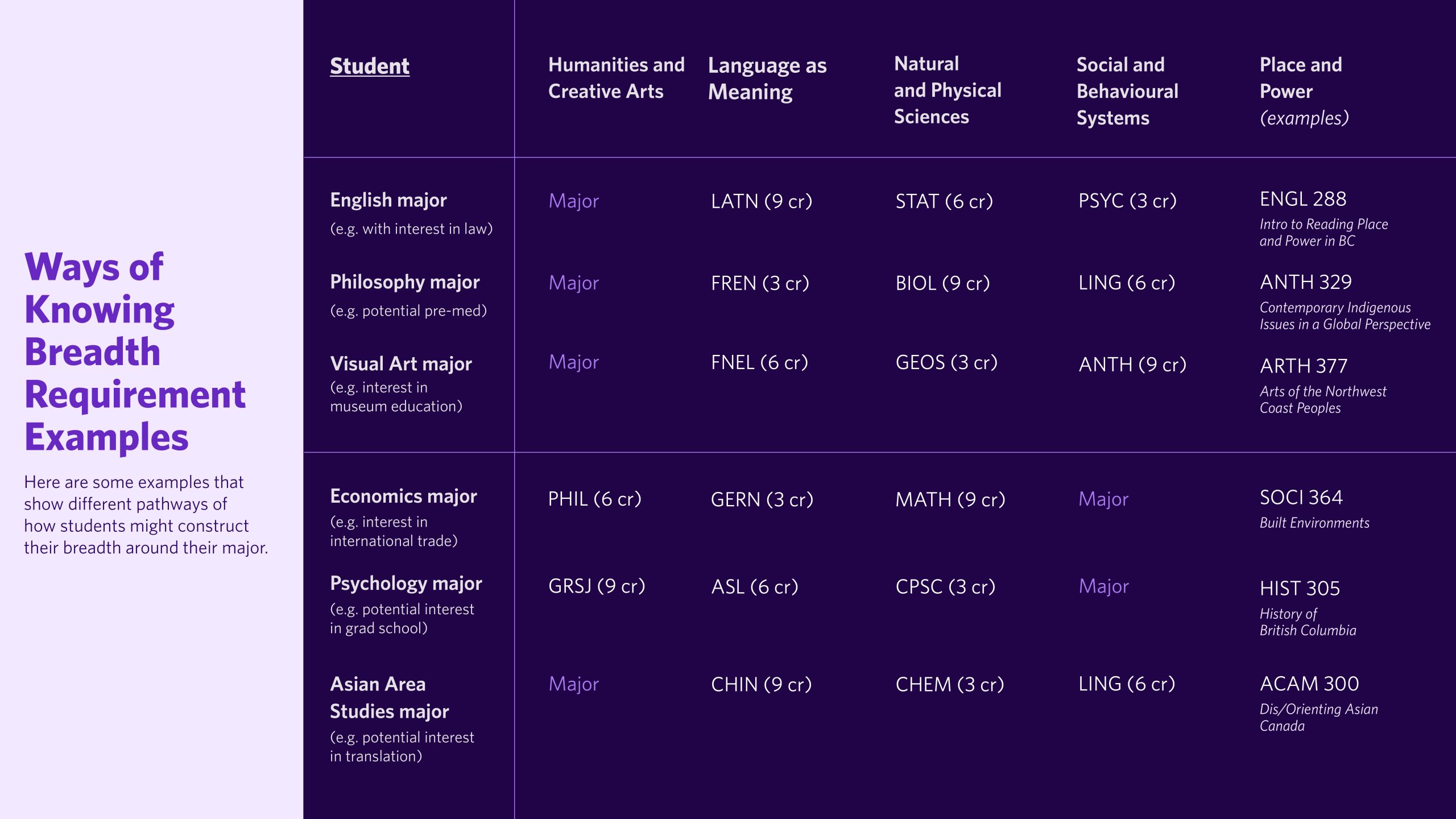

As a Bachelor of Arts student, you must fulfil specific faculty requirements in order to graduate. As you develop a year-by-year plan and explore your course options, it’s important to understand these requirements so you can navigate your studies effectively.
Here’s a crash course in what you need to do to get that cap and gown in the future!
Jump ahead:
- “Ways of Knowing” breadth requirement
- Writing and Research requirement
- Outside requirement
- Upper level requirement
- Arts Credit Minimum requirement
- How to pace out your degree
Degree Requirements Breakdown
In order to earn a Bachelor of Arts (BA) degree, you’ll need to complete at least 120 credits and fulfill the degree requirements. Read on to learn more about these important elements of your degree.
“Ways of Knowing” breadth requirement
While your major will provide you with a depth of knowledge in your chosen field, completing up to 21 credits across the Ways of Knowing breadth requirement will empower you to engage with diverse subject areas and disciplines so that you can design a personalized program of study that aligns with your academic, career, and personal goals.
Ways of Knowing contains two components (up to 21 credits):
- Place and Power (3 credits)
- Areas of Breadth (18 credits)
- Humanities and Creative Arts (3, 6 or 9 Credits)
- Language as Meaning (3, 6 or 9 Credits)
- Natural and Physical Sciences (3, 6 or 9 Credits)
- Social and Behavioural Systems (3, 6 or 9 Credits)
Your major will encompass deep engagement in one of these areas, so to complement this, you may choose how many credits – nine, six, or three – to spend in each of the three remaining Areas of Breadth, for a total of 18 credits.
If, for example, you intend to major in English, but have an interest in law, your major would give you a depth of knowledge in the Humanities and Creative Arts, which you could complement with 9 credits from Language as Meaning (e.g.: Latin), 6 credits from Natural and Physical Sciences (e.g.: Statistics), and 3 credits from Social and Behavioural Systems (e.g.: Psychology).
Taking at least one Place and Power course during your degree will invite you to understand your role “inside the story” of the lands on which UBC is situated and the systems of power, social relations, structures of inequality, and the diversity of cultural identities and communities that have made up and continue to make up that story.


Ways of Knowing Breadth Requirement examples
The potential combinations of courses that could fulfill this requirement are virtually endless. You will have control over which areas of breadth you’d like to prioritize, ensuring that your selection of courses remains deeply relevant to your individual interests, goals and aspirations.
Writing and Research requirement
As an Arts student, you must fulfill six credits towards the Writing and Research requirement, made up of three credits in a writing-focused course and three credits in a research-intensive course. Plan to take your writing course at the start of your studies (you must begin this in your first year), and your research-intensive course near the end.
Think of Writing and Research as bookends to your degree. The Writing Component will give you foundational skills for success in university-level coursework. The Research Component is a culmination of all of the reading, research and learning you’ve undergone in your degree program, preparing you to contribute to knowledge in your field and scholarly community.
Outside requirement
Along with the Ways of Knowing Breadth Requirement, the outside credit requirement ensures that you have opportunities to personalize your Arts degree by choosing a variety of elective courses to compliment your major. If you have a single major, your outside requirement is typically 60 credits. Adding additional programs will reduce this requirement.
Upper-level requirement
Your Arts degree will give you a breadth of knowledge in many topics, but will also give you an opportunity to develop an expertise in your chosen field. The upper-level requirement ensures that you’ll complete the in-depth coursework required to build a foundation for professional success. If you are enrolled in a single major, a combined major or the Interdisciplinary Studies (IDST) program, you must complete 48 credits in courses numbered 300 or above. Enrolment in a second major or honours programs will increase your upper-level credit requirement.
Arts Credit Minimum requirement
There are many faculties and schools at UBC offering exciting and innovative programs, giving you ample interdisciplinary opportunities to explore. However, to ensure that you’ll qualify for a Bachelor of Arts degree, a minimum of 72 of the 120 credits required to graduate must be taken within the Faculty of Arts. This may be reduced if the completion of your program requires more than 48 credits outside of Arts.
How to pace your degree
Your course load is a big consideration when it comes to progressing through the degree requirements. Many students take 12–15 credits (4–5 courses) per Winter term, but how many credits you should take will depend on your individual circumstances and additional commitments. The minimum number of credits needed to maintain full-time standing is 9.
While the Writing Component must be attempted in Year 1, there is no fixed schedule for when you should complete each of the other parts of the degree requirements. It’s a good idea to start your degree planning early, but your first years are also about taking the time to explore your options and find out what you’re interested in.
You’ve now completed your crash course in Degree Requirements. We’re excited to help you map out your plan and give you all the tools and information you need to obtain your Arts degree. Enjoy the road ahead, and remember, if you have any questions along the way, your Arts Advising team is here to help.


